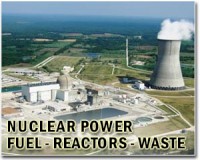 |
Paris (AFP) Feb 9, 2010 Enriching uranium for nuclear power -- or building a weapon of mass destruction -- lies at the heart of the controversy surrounding Iran's nuclear programme. The point of enrichment, the focus of the latest tensions between Iran and western nations, is to boost the ratio in uranium of the uranium-235 isotope, which splits in a chain reaction and releases energy. Enriching uranium to the point where it comprises three to five percent of uranium-235 enables engineers to make fuel for a nuclear reactor, which requires a slow, controllable chain reaction. But by boosting the U-235 to 90 percent or more, engineers can make the material for a nuclear bomb, which needs a very fast, violent fissile process. Iran announced Tuesday that it is aiming for 20 percent enrichment, drawing new criticism from countries who suspect it seeks a bomb and are seeking to limit the programme. The enrichment method used by Iran is a classic type in which uranium hexafluoride (UF6) gas is whizzed around in a centrifuge at very high speeds. A different isotope, called uranium-238, is separated from the mass by this centrifugal force. Because it is slightly denser than U-235, the U-238 gathers at the bottom of the chamber and can thus be extracted. The lighter atoms with the precious U-235 isotope are collected and put into another centrifuge, and the process is repeated again and again, in a so-called cascade, in order to boost the proportion of fissile atoms. The process is long because only 0.7 percent of naturally-occurring uranium atoms are U-235, and the remainder are all U-238. The collected U-238 can be used in "depleted uranium" weapons, providing a heavy slug for armour-piercing shells. When the desired enrichment level is reached, the gas is converted by chemical process to a uranium oxide (UO2) which is used as fuel pellets for a nuclear reactor. If a bomb is sought, highly enriched oxide is engineered into ingots of uranium metal. But for a bomb to work, there has to be enough material to generate a critical mass that sustains the chain reaction. The bomb-maker also has to master the key technologies of shaping the charge and controlling the detonation sequence so that critical mass actually happens, rather than fizzes out, and occurs at the desired time rather than prematurely or accidentally. Iran is under suspicion by Washington and other nations of wanting to build a nuclear bomb. It replies that its programme is only for peaceful purposes. Etienne Pochon, director of security and non-proliferation at France's Atomic Energy Commission (CEA), said there was nothing to stop Iran using its current technology to get 20 percent enriched uranium. "It is then possible to go further with a new layout of the centrifuges to enrichment of 60 to 90 percent," Pochon told AFP. "The main difficulty is legal rather than technical."
Share This Article With Planet Earth
Related Links Nuclear Power News - Nuclear Science, Nuclear Technology Powering The World in the 21st Century at Energy-Daily.com
 Iran has notified IAEA of uranium enrichment plans: envoy
Iran has notified IAEA of uranium enrichment plans: envoyVienna (AFP) Feb 8, 2010 Iran officially notified the UN nuclear watchdog Monday of its plans to produce 20 percent enriched uranium, Tehran's envoy to the International Atomic Energy Agency told AFP. "About 12 o'clock today, we delivered a letter officially announcing to the agency that we are going to start activities for the enrichment up to 20 percent in order to produce the fuel required for the Tehran researc ... read more |
|
| The content herein, unless otherwise known to be public domain, are Copyright 1995-2010 - SpaceDaily. AFP and UPI Wire Stories are copyright Agence France-Presse and United Press International. ESA Portal Reports are copyright European Space Agency. All NASA sourced material is public domain. Additional copyrights may apply in whole or part to other bona fide parties. Advertising does not imply endorsement,agreement or approval of any opinions, statements or information provided by SpaceDaily on any Web page published or hosted by SpaceDaily. Privacy Statement |